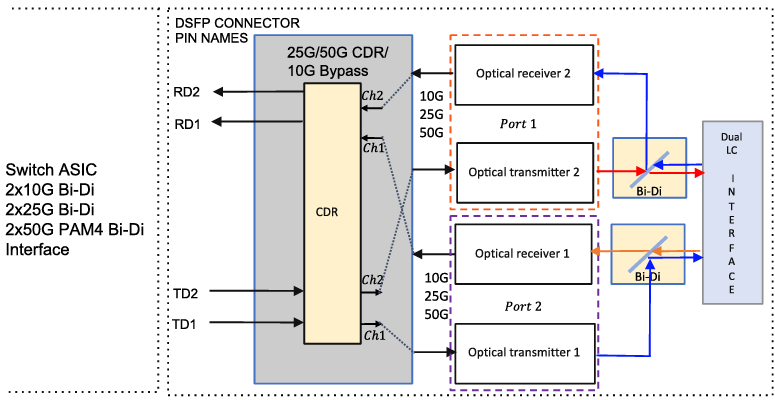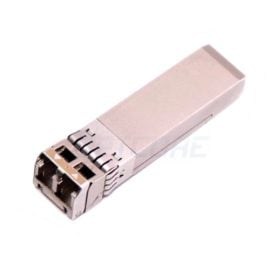Blog, Optical Transceiver
What Is DSFP? A Complete Guide
The DSFP MSA defines the DSFP form factor by doubling the data rate and port density of the SFP. It aims to meet the growing number of 5G networks and the high bandwidth requirements of data centers.
Along with the DSFP interface, there are two other 100G interface standards: SFP-DD and SFP112. What all three of them have in common is that they have the same mechanical dimensions as the SFP module, which are small. And what is the difference between them? How to choose?
Table of contents
What is SFP?
SFP stands for Small Form-factor Pluggable, a small module. Introduced in 2001 to replace the larger GBIC, SFP is also known as Mini-GBIC. The SFP module supports a 1Gbps data transmission rate.
In 2006, an enhanced version of the SFP, the 10Gbps SFP+ module, was introduced, and in 2014, the 25Gbps SFP28 module was introduced. With the introduction of higher-speed modules and the development of 5G Internet, SFP modules are now being phased out of the market.

What is DSFP?
DSFP stands for Dual Small Form-Factor Pluggable. The DSFP MSA (Dual Small Form-Factor Pluggable Multi-Source Agreement) released the DSFP Module Hardware Specification Revision 1.0 on September 12, 2018. This revision intends to double the density of SFP modules in the exact mechanical dimensions and maintain compatibility with existing SFP modules and cables.
DSFP modules support two electrical channels, twice as many as the original SFP modules. Each channel supports transmission rates up to 28Gbps (NRZ modulation) and 56Gbps (PAM4 modulation), so it can support up to 228=56Gbps (NRZ modulation) and 256=112Gbps (PAM4 modulation).

What is DSFP Port?
A DSFP port is a port on a switch or NIC that supports inserting a DSFP module. NVIDIA and Arista also have NICs and switches with DSFP ports that can be used with them. To maintain backward compatibility, SFP, SFP+ modules, and DSFP AOC cables can be inserted into this port type.
DSFP Features
- Compatibility: DSFP is compatible with existing SFP+ modules and cables. i.e., DSFP modules can be plugged into existing SFP ports. However, it is essential to realize that it does not achieve the optimal DSFP transmission bandwidth and performance when feasible.
- High Density and Low Cost: DSFPs double the density within the original SFP module space, making them an efficient and effective solution.
- High-Speed Transmission Capability: DSFP supports two electrical channels and achieves transmission rates up to 112Gbps with PAM4 modulation;
- Wide Range of Applications: DSFPs suit many network environments, such as data centers, wireless networks, and 5G mobile infrastructures.
- Design and Manufacturing Advantage: The DSFP structure is simple, and the connector design challenges are relatively small. A DSFP female port will be much better for the equipment.
DSFP vs. SFP112 vs SFP-DD
Package Format
- SFP112: SFP package form, but its internal structure is optimized to support higher data rates.
- SFP-DD: doubles the number of pins on top of the original SFP to support higher data rates.
- DSFP: Two additional pins are added to the original SFP, mainly used to increase the rate and signal integrity.
Number of Pins
- SFP112: Keep the original 20 pins unchanged.
- SFP-DD: Increased to 40 pins. Doubling the number of pins facilitates high-frequency signal fan-out, allows the same GND reference plane to be used, and has good SI reliability.
- DSFP: Increased to 22 pins. Increasing two pins is unfavorable for high-frequency signal fan-out, and different GND reference planes must be used; SI reliability is poor.
Application Scenarios
- SFP112: Suitable for low-power, high-density data center environments with high future scalability.
- SFP-DD: Widely used in data centers requiring high-density connectivity. Ideal for scenarios requiring smooth upgrades of existing network equipment due to downward compatibility with existing SFP/SFP+ ports.
- DSFP: It is Suitable for high-density bandwidth application scenarios such as data centers and emerging 5G networks. It is cost-effective due to its simple structure and compatibility with existing SFP+ interfaces.
| Characteristic | SFP112 | SFP-DD | DSFP |
| Form factor | SFP112 | SFP-DD | DSFP |
| Number of pins | No additional (20pin) | Double (40pin) | Add two pins (22pin) |
| Total rate | 112 Gbps | 112 Gbps | Up to 112 Gbps |
| Modulation | PAM4 | NRZ or PAM4 | NRZ or PAM4 |
| Compatibility | Backwards compatible with SFP, SFP+, SFP28, SFP56 SFP、SFP+、SFP28、SFP56 | Backwards compatible with SFP, SFP+, SFP28, SFP56 SFP、SFP+、SFP28、SFP56 | Backward compatible with SFP+、SFP28 |
| Application scenarios | High-end data centers for future expansion | Data center, support smooth upgrades | Data centers, 5G networks |
| Market demand | The current market demand is limited | High-end market, stable demand | Cost-effective, high demand |
| Design challenges | High power consumption limitations, high technical complexity | The design is relatively complex, but the compatibility is good | The design is relatively simple, and the cost is low |
FAQ
Q. What is the difference between SFP112 and SFP28?
A. SFP112 is rated at 100 Gbit/s, and SFP28 is rated at 25 Gbit/s. SFP112 is backward compatible with SFP, SFP+, SFP28, and SFP56, while SFP28 is backward compatible with SFP and SFP+.
Q. Can 10G, 25G, and 50G SFPs be used with DSFP ports?
A. Yes, DSFP ports can be considered “quad-rate” ports, supporting 10G, 25G, and 50G SFP fiber and cable and 100G SFP copper.
Q. What is NRZ modulation?
A. NRZ stands for “non-return-to-zero” modulation and describes an electrical or optical data channel with only two amplitude levels (or symbols), where one amplitude level represents the number ‘1’ and the other amplitude represents the number ‘0’. This is the primary modulation scheme for transmitting data up to 25Gb/s and is the simplest way to transmit digital data.
Q. What is 100G DSFP AOC?
A. DSFP AOC is an active fiber optic cable. 100G DSFP AOC cables comply with DSFP MSA, IEE802.3cd, and CMIS rev4.0 protocols to achieve optoelectronic transmission rates of up to 100Gbps and support transmission distances of up to 100m.
-
 Cisco DS-SFP-FC32G-SW Compatible 32G Fibre Channel SFP28 850nm 100m TransceiverUS$ 79.00 (Excl. VAT)
Cisco DS-SFP-FC32G-SW Compatible 32G Fibre Channel SFP28 850nm 100m TransceiverUS$ 79.00 (Excl. VAT) -
 Cisco SFP-10G-SR Compatible 10GBASE-SR SFP+ 850nm 300m TransceiverUS$ 8.00 (Excl. VAT)
Cisco SFP-10G-SR Compatible 10GBASE-SR SFP+ 850nm 300m TransceiverUS$ 8.00 (Excl. VAT) -
 HW QSFP-100G-SR4 Compatible 100GBASE-SR4 QSFP28 850nm 100m TransceiverUS$ 32.90 (Excl. VAT)
HW QSFP-100G-SR4 Compatible 100GBASE-SR4 QSFP28 850nm 100m TransceiverUS$ 32.90 (Excl. VAT) -
 Dell AOC-QSFP-100G-20M Compatible 20m (66ft) 100G QSFP28 Active Optical CableUS$ 146.00 (Excl. VAT)
Dell AOC-QSFP-100G-20M Compatible 20m (66ft) 100G QSFP28 Active Optical CableUS$ 146.00 (Excl. VAT) -
 Mellanox MCP1600-C003 Compatible 3m (10ft) 100G QSFP28 Passive Copper CableUS$ 38.00 (Excl. VAT)
Mellanox MCP1600-C003 Compatible 3m (10ft) 100G QSFP28 Passive Copper CableUS$ 38.00 (Excl. VAT)
Conclusion
Compact and intelligent drive the continuous development of optical modules. With network bandwidth and density constantly improving, the market increasingly favors small-size, high-bandwidth transceivers. This article introduces the DSFP, a new module type, and how it differs from the SFP112 and SFP-DD modules.
After you understand their respective characteristics and application scenarios, you can make the right choice based on your network traffic requirements and future network planning.
Reference
Read more:
- What is SFP Module? An Ultimate Guide
- What is SFP Port? Everything You Need to Know
- What is SFP+ Module? An Ultimate Guide
- Multi-Source Agreement: A Beginner Guide







